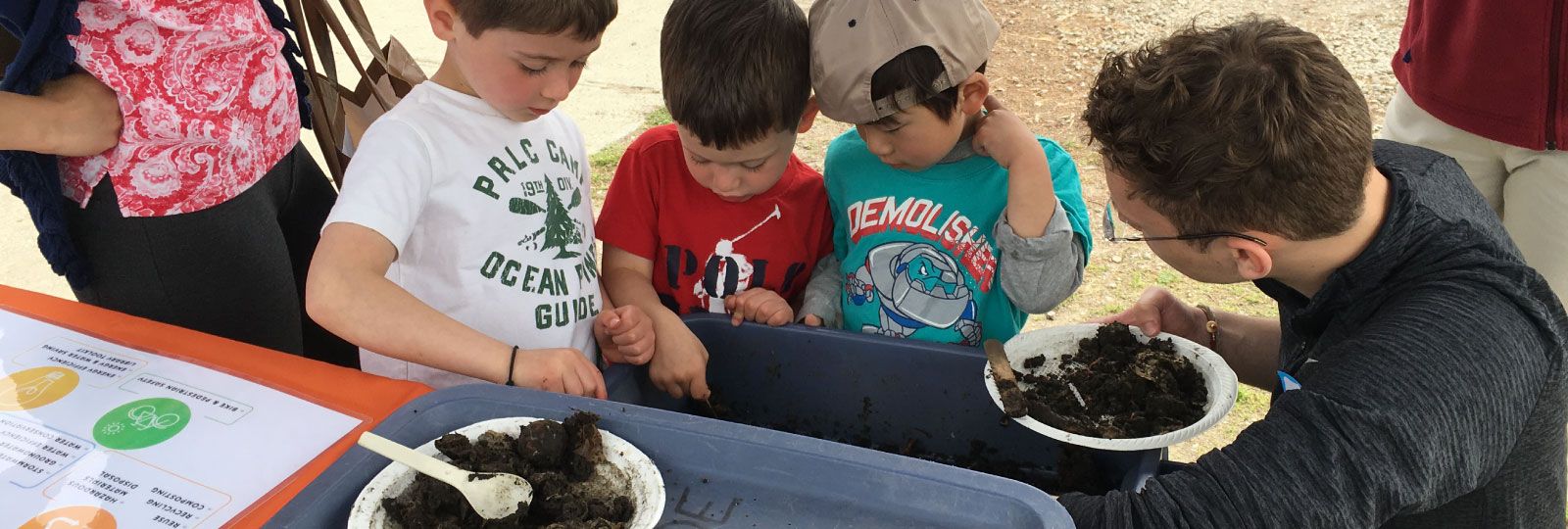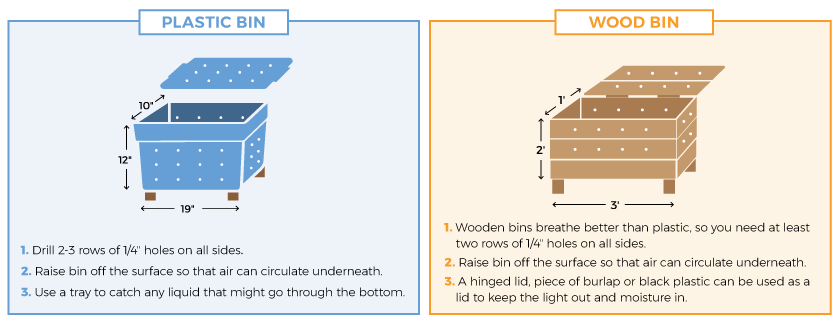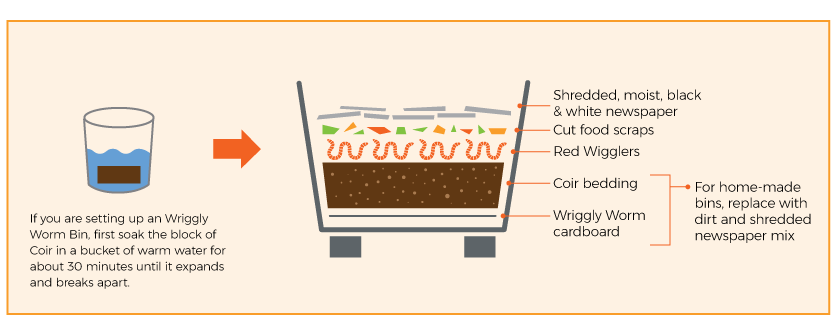Composting
Composting organic items like food scraps and yard debris is not only a great way to reduce the amount of waste we send to the landfill, but it’s also easy! If your hauler provides the curbside collection of compostable materials (check our hauler map), then the process is as simple as taking out your recycling or garbage. You can also compost at home by creating a backyard compost pile, by utilizing worms to create vermicompost, or by grasscycling. All of these at-home methods have the added benefit of giving you a wonderful soil amendment for your plants.
Residents
CURBSIDE COMPOSTING COLLECTION
Please check our hauler map to determine if your hauler provides curbside collection services, as well as what materials are accepted in the cart.
HOW TO START COMPOSTING AT HOME
TAKE A WORKSHOP!
Use the resources on this page to get started and as a reference. If you’d like to learn more, ask a composting expert questions, and connect with others, check out our upcoming composting workshops at the Sustainability Academy here!
Choose a type of composting system to learn more
Backyard Composting
Backyard composting is a great way to recycle your yard and food waste into a useful, nutrient rich, fertilizer for your garden. It involves piling up organic waste, and then maintaining that pile while micro and macro organisms break down what is inside.
WHAT TYPE OF BIN SHOULD I USE?
Many people prefer a holding bin to keep composting piles confined to a smaller space. Keep the bin 4 feet or lower for easy access for turning or purchase a compost tumbler or barrel.
ARE THERE DISCOUNTS FOR COMPOST BINS?
Bins can be purchased at a discounted price online or you can get a rebate for building your own bin from the County of San Mateo Sustainability Department! Here are directions to build your own stackable bin or 3 bin system. If you attend a composting workshop, receive an additional discount up to $30 that can be added to a discounted bin or the $200 rebate if you build your own bin. One rebate OR discount per household or business located in San Mateo County.
HOW DO I LEARN MORE ABOUT COMPOSTING?
Attend a composting workshop to learn how easy and fun composting is!
WHERE SHOULD I PUT MY BIN?
Your location should be a level, well–drained surface at least two feet away from any fence or structure, with easy access to water.
WHAT GOES IN A COMPOST PILE?
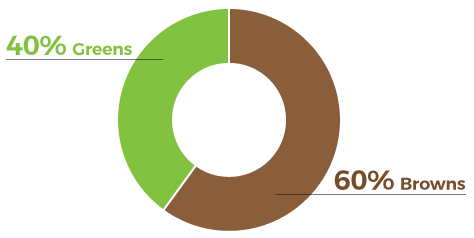
Add approximately 60% browns to 40% greens. Chopping up material into smaller sizes increases the surface area for bacteria to work.

GREENS
Good Sources of Nitrogen
- Grass clippings
- Coffee grounds and filters
- Fruit and vegetables
- Egg shells
- Manure from herbivores (do not use if an animal is sick)
- Tea bags
- Hair and feathers (human or animal, may be slow to degrade)
- Grains

BROWNS
Good Sources of Carbon
- Leaves
- Straw
- Sawdust (from untreated wood)
- Newspaper
- Yard waste (best cut to sizes 2″ or less)
- Paperboard (break into small pieces)
- Dried grasses
- Wood ash

WHAT TO AVOID
- Diseased plants
- Weeds with seeds or roots
- Dog or cat feces
- Toxic chemicals
- Charcoal briquettes
- Fats, oils, and grease
- Meat scraps, bones, and cheese
- Treated logs
SHOULD I ADD WATER?
Add water as you build the pile to evenly distribute moisture throughout. Keep as moist as possible – microbes require moisture to survive.
SHOULD I TURN THE PILE?
Turning or mixing the pile periodically has many benefits, including:
- Reducing odor
- Adding oxygen
- Breaking up compacted material
- Helping to destroy unwanted disease
- Helping maintain beneficial microbes
- Helping maintain an optimal temperature
- If the temperature is less than 100°F or more than 150°F. Thermophilic bacteria are the fastest at turning material into compost and prefer temperatures in the 105–140°F range.
HOW DO I AVOID COMMON COMPOST PROBLEMS?

Pile will not heat up
- Pile is too dry. Add water and turn.
- Lack of greens.
Odors
- Too much moisture (either from over watering or from having too many “greens” in your pile) can create odor problems and slow the composting process.
- Turn the pile and add dry browns to the mix.
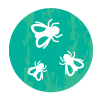
Flies
- Fruit flies are attracted to food scraps that are exposed on top of a pile.
- Always put your food waste in the middle of the pile and bury it into a few inches of brown material.

Pests, e.g., raccoons, rats
- Pests are attracted to exposed food scraps, especially meat, poultry, fish and fats
- Turn pile to increase temperature or cover food with leaves Bury food a few inches down in the center of the pile.
- Keep all lids fastened.
- Line the bottom of the bin with a small mesh wire.
Worm Composting
Let the worms do the work! Worm composting produces vermicompost: a nutrient-rich material that can be used as a concentrated soil amendment. A happy home is a healthy home and a compost bin is the perfect place for worms!
HOW DO I GET STARTED?
You need a place for your worms to live. You can purchase a worm bin at a discounted price from the County of San Mateo Sustainability Department, build your own wooden bin or purchase a plastic container with a lid and make a bin. Whichever bin you choose, your worms will need a shallow place to live in that allows plenty of air to circulate.
HOW DO I LEARN MORE ABOUT COMPOSTING?
Attend a composting workshop to learn how easy and fun composting is!
WHAT TYPE OF WORMS SHOULD I USE?
 The worms best suited for a worm bin are red wrigglers. They live close to the surface of the ground, process large amounts of organic material, reproduce quickly and tolerate a wide range of temperatures (they are happiest at temperatures between 59-77°F), acidity and moisture conditions. All this makes them the ideal worm to use in a worm bin.
The worms best suited for a worm bin are red wrigglers. They live close to the surface of the ground, process large amounts of organic material, reproduce quickly and tolerate a wide range of temperatures (they are happiest at temperatures between 59-77°F), acidity and moisture conditions. All this makes them the ideal worm to use in a worm bin.
HOW DO I BUILD A WORM BIN?
HOW DO I PREPARE A WORM BIN?
WHERE CAN I PUT MY WORM BIN?
It must be protected from direct rain, sun and/or excessive cold. Your bin can be placed indoors (there should be NO odor) or if you prefer, put it in a sheltered outdoor location such as a shed, garage, carport or balcony.
HOW DO I FEED MY WORMS?
- Select foods that are suitable for worms including most fruits, vegetables, cereals and grains, and other organic items like cardboard and tea bags.
- It is best to cut food scraps into small pieces before placing them in the bin. The smaller the pieces the more surface area there is for bacteria to start breaking down the food, making it easier for the worms to consume. Some people put their food scraps, including eggshells, into a blender and make a slurry. The worms seem to love this, but it is not necessary.
- Keep shredded black and white newspaper over the food at all times. Newspaper or bedding helps keep the bin dark and moist and discourages fruit flies. Other organic material such as burlap or shredded cardboard or paperboard can also be used. The worms live in these materials and they also eat them.
- To feed the worms, place the food under the newspaper in a different part of the bin each time. Do not bury the food in the castings.
WHAT DO I FEED MY WORMS?
 Yes
Yes
- Fruit
- Vegetables
- Cereals and grains
- Miscellaneous: coffee filter paper, tea bags, eggshells, dead flowers
- Other food/bedding: newspaper (nothing shiny or coated), cardboard, paperboard, paper egg cartons, brown leaves
 Limited Quantities
Limited Quantities
- Breads
- Potato skins, onions, garlic, and ginger
- Coffee grounds
 No
No
- Meat, poultry, fish, dairy (protein attracts rodents)
- Potato chips, candy, oils (worms do not like junk food and these attract ants)
- Oranges, lemons, limes (most citrus has a chemical substance, limonene, that is toxic to worms)
- Non–biodegradable materials that do not belong in your bin include plastic, rubber bands, sponges, aluminum foil, glass, and dog or cat feces
HOW DO I AVOID COMMON COMPOST PROBLEMS?

Moldy food
- If you have fed the worms too much, the food might become moldy instead of being eaten.
- Remove moldy food as worms are unlikely to eat it and it makes the system vulnerable to infestations from other microorganisms.

Offensive odor
- Uneaten food has started to rot
- Make sure there is a generous amount of damp newspaper or cardboard placed over the food and stop feeding for a week
- Add rock dust or crushed oyster shells

Worms trying to escape
- Bin may be too wet or too dry
- Add more dry bedding if too wet, or moisten bedding if too dry
GRASSCYCLING
Grasscycling is simply leaving your grass clippings on the lawn.
HOW DO I GRASSCYCLE?
Basic Rule: Do not cut any more than 1/3 of the length of the grass blade at one time.
Proper mowing is the key to grasscycling. Grass should be dry and the mower blades sharp. In the fast–growing season you may have to cut every seven days-but in the slower growing season you might only need to cut your lawn every 7–14 days.
During a “wet season” or at a time your grass cannot be mowed as frequently as desired, you might have an excess of clippings. This is an excellent opportunity to put your clippings in a backyard compost pile.
HOW DO I WATER THE LAWN WITH GRASSCYCLING?
Water in the early morning if possible. Do not over–water. Too much water will cause your lawn to develop shallow root systems. Water less frequently but deeper.
SHOULD I FERTILIZE MY LAWN?
Do not over–fertilize. Proper fertilization is important, however, over–fertilization can weaken a lawn by causing excessive growth. It is best to apply smaller quantities more frequently.
WILL ANY LAWN MOWER WORK?
There are several brands of recycling mowers available that cut grass into small pieces and force them into the soil. However, you do not necessarily need to purchase a recycling mower to grasscycle. Almost any mower will work by raising the cutting height. If your mower has a collection bag, remove it to allow clippings to drop into the soil. However, if your mower does not have a safety flap covering the opening where the bag fits into the chute, or a plug for the chute, contact your local retailer to purchase a retrofit kit.
WHAT ARE SOME COMMON MISCONCEPTIONS?
- Grasscycling causes thatch buildup. Studies have shown that grass roots are the primary cause of thatch, not grass clippings. And, a small amount of thatch is actually beneficial. It serves as a mulch, preventing water evaporation and soil compaction.
- Grasscycling spreads lawn disease. The primary cause of disease spread is improper watering and fertilizing. If a disease is present, infestation will occur whether you are grasscycling or not.
- My lawn will look bad. Grasscycling will give you a healthier looking lawn if it is mowed, watered, and fertilized properly.
Grasscycling is not new. Many parks and golf courses have been practicing grasscycling successfully for years.
COMMUNITY GARDEN PARTNERSHIPS
The Sustainability Department is currently looking to partner with local community organizations and businesses to build vibrant community gardens and to promote sustainable composting techniques. The goal of the program is to provide the opportunity for community members to learn about composting through the gardens, and ultimately, practice the composting techniques at home and reduce the amount of organic wastes from being sent to landfills. Gardeners can also use compost as a soil amendment to grow nutritious and fresh produce!


The Sustainability Department will provide funding and resources to help start up and maintain the gardens, while the partnering organization’s role is to use the funding to build the garden, coordinate with the gardeners to keep the garden up and growing, and promote composting and sustainable gardening. Please reach out to us if your organization is interested in getting started on a community garden!
Click here to learn more about the Community Garden Partnership Program.
If you are interested in partnering with us, please fill out this form.
The map shows our partner community gardens that are open to the public. Please feel free to come visit any of the gardens and check out the composting systems in place!
BUSINESSES
As of January 2017, all businesses that generate more than 4 cubic yards of organic waste must provide compost collection services, either through a curbside program, by self-hauling waste to a transfer station, or through the methods outlined above. For more information, please visit CalRecycle’s website.

